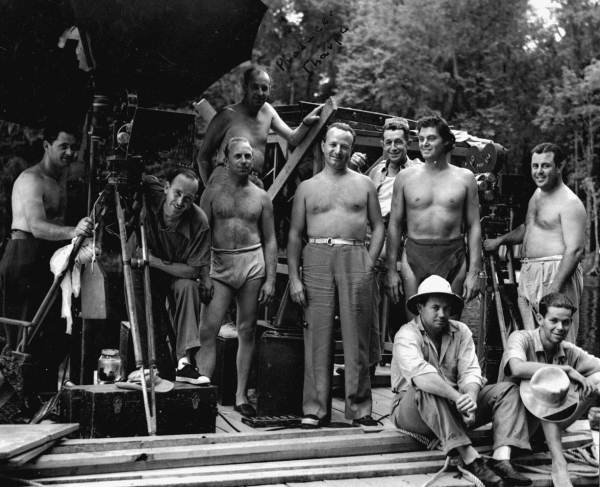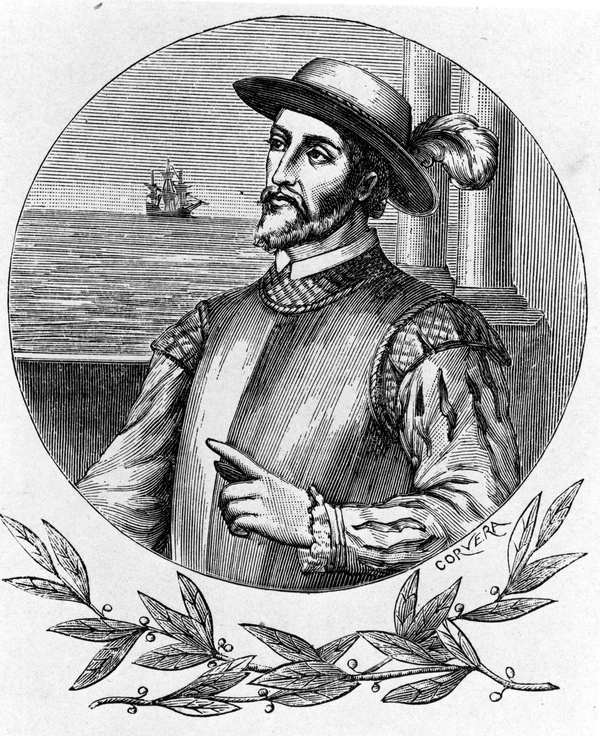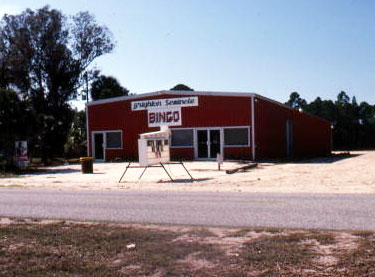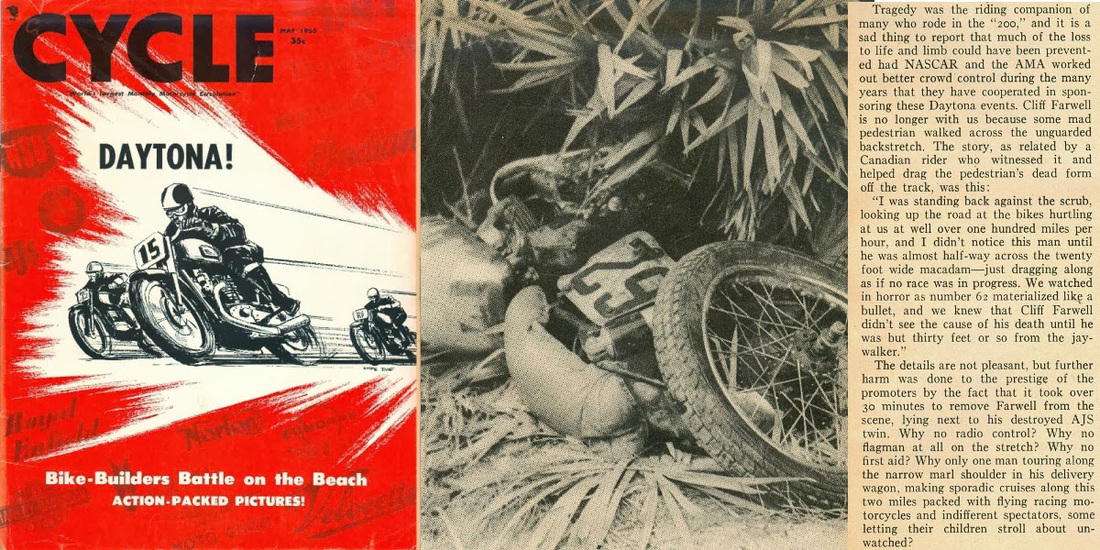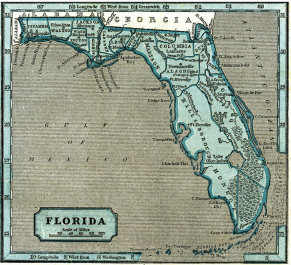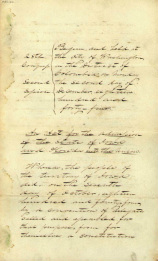March 31, 1947: Campaign launched to save colorful tree snails
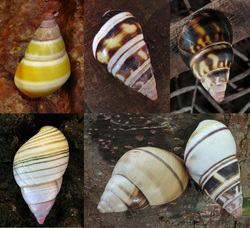
You've probably heard about the current war on invasive Giant African Land Snails in Miami-Dade County. Those grow as big as rats and can devour your home's stucco and plaster. Those are bad snails. But South Florida is also home to good snails. The brightly hued Liguus, also known as Florida tree snails, once lived in an area extending from Key West north to Boca Raton. Now they are mostly found in Everglades National Park, Big Cypress National Preserve, and parts of the Keys. Fifty-eight color varieties have been observed but several are now extinct and others are very rare. Their varied colors and patterns create the appearance of Easter eggs. Blacks, whites, greens, browns, blues and yellows can appear as stripes, flames and washes. Hobbyists collected them obsessively in South Florida in the late 19th and early 20th century. In 1947, the state parks service launched a campaign to protect them, a story in the Miami Daily News reported. Park Service Director L.G. Scoggin said some collectors were so fanatical they would find a colony of uniquely marked specimens, select a few for their own collections, and then burn the woods around the colony to establish the collected ones as rarities. By and large, collectors voiced support for the protection campaign. Between 1957 and 1980, collectors worked with the National Park Service to introduce 51 color varieties into Everglades National Park and Big Cypress National Preserve, but several of those have disappeared, according to the United States Geological Service's Southeast Ecological Science Center website. Florida tree snails are today listed by the Florida Game and Fresh Water Fish Commission as a Species of Special Concern. Collecting is no longer allowed on public or private lands in South Florida. Read the story in the Miami Daily News: Florida Moves to Protect Its Tree-Climbing Snails • Read about Florida tree snails at the USGS website
March 30, 1962: Feds say Castro sent cocaine to demoralize U.S.
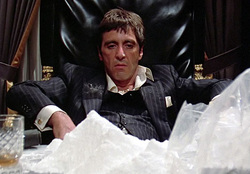
Six pounds of cocaine seized in Miami was part of a Communist Cuban plot to demoralize the nation and discredit anti-Castro Cubans, federal authorities said. The cocaine was valued at $750,000. Charles Siragusa, acting commissioner of Narcotics in Washington, said the cocaine was intended to raise money for Cuba's young Communist government, but also to further the "demoralization of U.S. citizens through the use of cocaine." A third reason, he said, was "to discredit anti-Castro Cuban refugees by encouraging their extended use of cocaine." He said virtually all of the cocaine seized in the U.S. since 1960 originated in Cuba. Read the Associated Press story in the Daytona Beach Morning Journal: Narcotics Men Seize $750,000 More In Drugs
March 29, 1953: Fire engulfs Largo nursing home, killing 33

Thirty-two elderly people and a heroic nurse were killed when a wind-driven fire swept rapidly through a rambling, old one-story nursing home south of Largo, according to news reports. It was the worst disaster in the history of Pinellas County, the St. Petersburg Times reported. Twenty-five residents escaped, including one who was rescued by the nurse who died. The fire started at about 3 a.m. and waged most of its destruction within 15 minutes. Ned Moren, 31, son in law of the nursing home's operator, said heavy winds prevented many rescues. "If the wind had been still, we might have saved all of them," he said. "But the wind kept shifting."
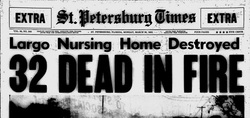
Many of the residents were senile and failed to make any effort to save themselves, he added. The St. Petersburg Times reported that none of the doomed made a sound. Fire officials said this may have indicated most of the dead were overcome by smoke or fumes while still asleep. Officials believed the fire started accidentally because one of the residents was smoking secretly in bed. The fire destroyed the nursing home's records, which hampered efforts to identify the victims. The nursing home had not been inspected in more than a year, the paper reported. The fire triggered calls for more inspections of nursing homes in Pinellas County, many of which were in "deplorable" condition, according to county health officials. Read the story in the St. Petersburg Times: Largo Nursing Home Destroyed: 32 Dead In Fire • Read the story in the Palm Beach Post: 33 Persons Perish In Fire In Nursing Home In Largo
March 28, 1935: Studios threaten Florida move in California tax fight
|
Call us Hollywood's bargaining chip. California-based film studios fought back against a proposed state income tax by threatening to move their movie making operations here, the St. Petersburg Times reported. "What a bluff!" retorted a California assemblyman. "Have you ever lived in Florida?" said another. But producer Joseph M. Schenck said he was seriously exploring the feasibility of establishing another Hollywood near Coral Gables.
|
"In 18 months time, at a lump cost that could be quickly offset by advantages other states offer, every studio could be moved out of California, beyond any question, the way is being paved for that," he said. Of course, Hollywood studios never pulled up stakes and moved to Florida. But studios have come and gone in Florida over the decades and hundreds of movies and television shows have been filmed here. But the dream that Florida could become another Hollywood has never died, and was most grandly acted out with the developments of Disney-MGM and Universal Studios Orlando in the 1980s as combination tourist attractions and actual production facilities. Read the story in the St. Petersburg Times: Californians Wrathful Over Movie Threat
March 27, 1513: Ponce de Leon sees, names La Florida
|
On Easter Sunday in 1513, Spanish explorer Juan Ponce de Leon spotted the Florida mainland for the first time as his three-ship fleet sailed in the Atlantic Ocean. He named the landmass "La Florida," after the Spanish term La Pascua Florida, which means Feast of the Flowers. The explorer planned to claim the new land -- which he thought might be an island -- for the King of Spain and decided to continue sailing north to determine its size. The fleet would not come ashore until April 2. Read more about Ponce de Leon in this report by Dr. Samuel P. Turner, Director of Archaeology for the Lighthouse Archaeological Maritime Program: The Caribbean World of Juan Ponce de Leon and His Discovery of Florida
|
March 26 - Apr. 1, 1928: Stunt ends with collapse of 'Miss Essex'
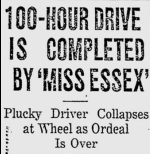
The young woman enlisted by the Miami News and its advertisers to attempt a 100-hour endurance drive handcuffed to the steering wheel of a 1928 Essex coach collapsed as she finished the stunt and was taken by ambulance to the hospital, the paper reported.
The newspaper hyped the stunt for more than a week and enlisted participation from local advertisers and police. Schedules of drive-by appearances at participating advertisers' locations were published each day for curious members of the public. "The public has already taken a keen interest in the drive, asking 'Do you think she'll make it?'" and calling out, "'Good luck, Miss Essex!'" and "'Stay with it!,'" the paper reported.
The newspaper hyped the stunt for more than a week and enlisted participation from local advertisers and police. Schedules of drive-by appearances at participating advertisers' locations were published each day for curious members of the public. "The public has already taken a keen interest in the drive, asking 'Do you think she'll make it?'" and calling out, "'Good luck, Miss Essex!'" and "'Stay with it!,'" the paper reported.
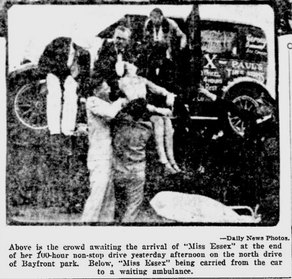
At the end of the first day, her hands were beginning to blister "from their unaccustomed constant contact with a steering wheel" and her ankles were beginning to swell from "the continuous use of brake and clutch pedals." In the dampness of the second night, "she caught cold and was given special massage treatment and wrapped in heavy blankets." Still, she was greeted by American Legion officials attending a state convention in Coral Gables, and escorted by motorcycle police on a tour around the city, the paper said. By day four, she reported cramped muscles and "intense pain in her neck because of the necessity of being constantly alert." Huge crowds gathered along her route "made her task more difficult."
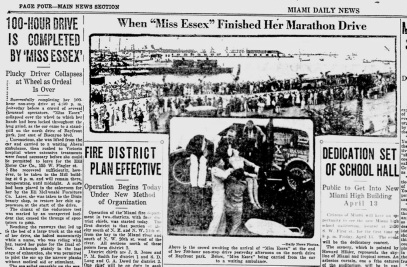
As she neared the last of the 100 hours, "only the constant reminder of a watch held before her during the drive" kept her awake. Finally, as she started to drive the car up a ramp onto a waiting flatbed truck, the woman fainted over the steering wheel. "Instantly her manager struck the windshield, shattering it to let in as much air as possible and the doors were thrown open. Attendants had begun lifting her from the car when it suddenly lurched backward. There was a tense moment before it was halted, the rear wheels on the edge of the platform."
She was lifted unconscious from the car and into a waiting ambulance -- supplied by Abern Undertaking -- and rushed to a hospital "where extensive treatments were found necessary before she could be permitted to leave for the Hill Motor Car Co." In the dealership's salesroom, she was allowed to rest in a bedroom suite supplied by the Eli McDonald Furniture Co. Finally, before appearing in public the next day, "Miss Essex" was taken to the Dixie Beauty Shop "to restore her chic."
Did any of this actually happen as described in these stories? Our B.S. detector was ringing like crazy as we read all of these accounts in the Miami Daily News. Would a newspaper, its advertisers and local authorities really permit someone to be put in such danger? The woman's real identity or age was never revealed and the only photo of her published was the one above of her being lifted from the car. But it was reported in the daily paper, so it had to be true, right?
Read the coverage in the Miami Daily News:
• March 26, 1928: 'Miss Essex' Starts Tuesday On Long Drive From City Hall
• March 27, 1928: 'Miss Essex' Is Handcuffed and Started on Long Journey
• March 28, 1928: 'Miss Essex' Is Going Strong After Day's Driving Over City
• March 29, 1928: 'Miss Essex' Despite Fatigue Keeps After 100-Hour Miami Driving Record
• March 31, 1928: 'Miss Essex' on Home Stretch of 100-Hour Drive
• April 1, 1928: 100-Hour Drive Is Completed by 'Miss Essex'
Did any of this actually happen as described in these stories? Our B.S. detector was ringing like crazy as we read all of these accounts in the Miami Daily News. Would a newspaper, its advertisers and local authorities really permit someone to be put in such danger? The woman's real identity or age was never revealed and the only photo of her published was the one above of her being lifted from the car. But it was reported in the daily paper, so it had to be true, right?
Read the coverage in the Miami Daily News:
• March 26, 1928: 'Miss Essex' Starts Tuesday On Long Drive From City Hall
• March 27, 1928: 'Miss Essex' Is Handcuffed and Started on Long Journey
• March 28, 1928: 'Miss Essex' Is Going Strong After Day's Driving Over City
• March 29, 1928: 'Miss Essex' Despite Fatigue Keeps After 100-Hour Miami Driving Record
• March 31, 1928: 'Miss Essex' on Home Stretch of 100-Hour Drive
• April 1, 1928: 100-Hour Drive Is Completed by 'Miss Essex'
March 25, 1928: Stunt revealed! Woman to attempt 100-hour drive in Essex coach -- while handcuffed to steering wheel
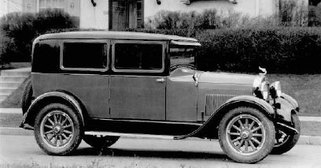 1928 Essex coach
1928 Essex coach
The Miami News announced that a young woman would be handcuffed to the steering wheel of a 1928 Essex coach as she attempts to drive around the city for 100 straight hours without stopping the car for food, sleep or rest. The stunt will begin at Miami City Hall when the city's Public Safety Director puts her in handcuffs, the paper reported. Plenty of the paper's advertisers are in on the stunt. The car will be furnished by the Hill Motor Co., local distributors of Hudson and Essex automobiles. When fuel is needed, "Miss Essex" will slowly circle the driveway of the Orange State Oil Co., "at which time an attendant will refuel the tank while the car is moving." If the car gets a flat tire, the owner of Paul's Tire Shop "assures that his service crew will change tires without having to stop the car."
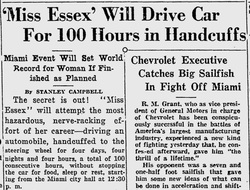
For nourishment, "Miss Essex" will exist solely on Jersey Ice Cream, supplied by a Jersey Ice Cream Co. truck that will meet her at assigned intervals. A nurse and a beautician will also be in the car each day, to ensure "Miss Essex" remains healthy and attractive. The drive would be a world record, the story said. "I want to prove to the people of Miami and vicinity that clean living and physical culture will overcome all odds," "Miss Essex" was quoted as saying. If she completes the 100 hours, "Miss Essex" will spend six hours of rest in a bedroom suite on the sales floor of the Hill Motor Co., on furniture provided by the Eli McDonald Furniture Co. And if that's not enough, there's this: "The Abern Undertakng establishment has placed their new Hellen ambulance at disposal of 'Miss Essex; and has secured the services of two trained nurses if needed by the young woman." Check back with Florida History Network tomorrow for an update on the record attempt. Read the story in the Miami News: 'Miss Essex' Will Drive Car For 100 Hours In Handcuffs
March 24, 1928: Beauty brought to Miami to attempt mystery stunt
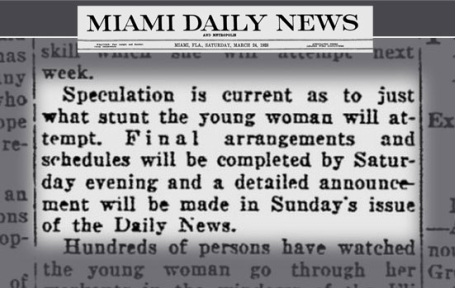
A young beauty queen dubbed "Miss Essex" by the Miami News is training to attempt a mystery stunt hyped by the newspaper and its advertising partners. The young woman — brought to Miami by the newspaper, a local Essex Motor Car dealer and several other local businesses — declared she is almost ready "for the unusual and hazardous test of nerve and skill which she will attempt next week," the paper reported in a front page story. "Speculation is current as to just what stunt the young woman will attempt," the story said before promising a detailed announcement in the paper's Sunday edition. "Hundreds of persons" have watched the "young athlete and sportswoman" working out in the windows of the Eli McDonald Furniture Co. on West Flagler Street "and have learned it is not necessary to tire and antagonize the muscles of the body to reach the peak of physical condition," the story said. Her last appearance in the store's windows will be at 8:30 p.m. in a four-round boxing match. The Jersey Ice Cream Co., which has been supplying ice cream to "Miss Essex" while she has been training, will be on hand during the match to give "generous samples of ice cream" to spectators. Visit Florida History Network tomorrow to learn about the stunt. Read the story in the Miami News: Physical Culturist About Ready For Trying Stunt in Miami Next Week
March 23, 1927: Ringling circus bringing winter HQ to Sarasota
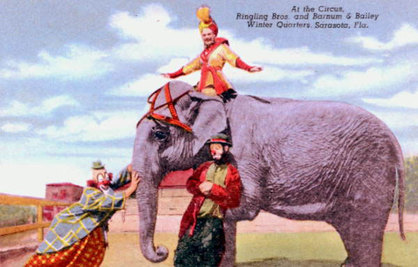
"Nationally known showman" John Ringling announced plans to establish his circus' permanent winter headquarters in Sarasota, an Associated Press story reported. The move would add 3,500 new residents to the city, including more than 300 circus families and laborers who will manufacture railway cars used in the circus' travels. The headquarters will be established on 200 acres at the Sarasota County Fairgrounds, the story said. The winter quarters opened to the public on Christmas Day in 1927. Adults were charged 25 cents and children 10 cents for a behind-the-scenes look at circus life. Ringling became a mainstay of the Sarasota community and established the John and Mable Ringling Museum of Art that same year. In 1948, the organization opened the Ringling Museum of the American Circus, which remains open today as the Ringling Circus Museum. The art museum has been operated by Florida State University since 2000. The winter headquarters moved to Venice after the 1959 season, to the State Fairgrounds in Tampa after 1992, and to a new 47-acre complex in Manatee County in 2013. Read a history of the Ringling Circus in Sarasoat at sarasotacircushistory.com
March 22, 1982 - Supreme Court to state: Hands off Seminole gaming
Seminole Indian gambling was off and running after the U.S. Supreme Court denied the state of Florida's bid to regulate dbingo games on the Seminole reservation west of Hollywood in Brevard County. The tribe had argued that bingo regulations would violate a federal law restricting state authority on Indian lands. The decision paved the way for the Seminoles to open seven full-sized casinos on six reservations throughout the state, as well as for parimutuels to argue they should be allowed to offer casino-style gaming to ward off competition from Seminole casinos and casino cruises. The court challenge focused on a bingo hall on property that is now home to the Seminole Hard Rock Hotel & Casino. Read the story in the Miami News: Florida loses challenge of Broward Seminoles' bingo
March 21, 1923: Anti-Mosquito Association meets in St. Petersburg
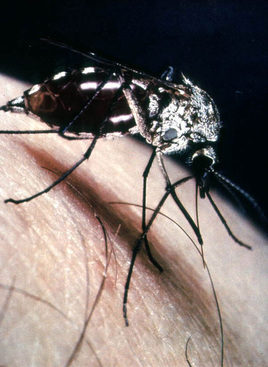 Photo: State Archives of Florida, Florida Memory
Photo: State Archives of Florida, Florida Memory
Two hundred and fifty members of the newly formed Florida Anti-Mosquito Association, "representing every progressive community in the state" convened in St. Petersburg for a two-day session that was open to the public, according to a story in the St. Petersburg Times. Sessions covered a range of mosquito control topics, including use of airplanes and involvement of governments in the "Anti-Mosquito War." Association vice president Dr. W.E.A. Wyman planned a lecture at St. Petersburg High School called "How to interest school children in anti-mosquito work and capitalize on their energy and interest." That was to be followed by a mosquito playlet performed by children of the Roser Park and Glenoak schools. The event's second day was to include an address by the Florida Federation of Women's Clubs' health committee chairman on "What the Women of Florida are Doing." Today, of course, use of wartime rhetoric when discussing mosquito control might seem strange. But in late-19th century Florida, mosquito-borne illnesses struck repeatedly and with tragic consequences. In 1877, 70 percent of Floridians caught yellow fever. One in 20 died. Dengue fever was also called breakbone fever because it resulted in broken bones. Malaria remains a global health scourge, with 219 million documented cases in 2010 alone.
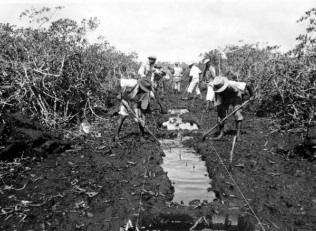 Ditch digging for mosquito control, 1935
Ditch digging for mosquito control, 1935
The first concerted mosquito eradication efforts took place in Florida around World War I and the following decades saw creation of mosquito control districts throughout the state and publicly funded efforts to dry out mosquitoes' favorite breeding and hatching areas - marshes and swamps - near population centers. Effectiveness of the insecticide DDT after World War II fueled the belief that the war on mosquitoes had been won - until the insects developed resistance to the chemical. The Florida Anti-Mosquito Association is now called the Florida Mosquito Control Association and its mission remains to promote public support for effective and environmentally sound methods of mosquito control and provide scientific advancement of members through meetings, training and education.
Read the story in the St. Petersburg Times: Anti Mosquito War Gathering Convenes Here • Read a history of mosquito control efforts from the University of Florida's Medical Entomology Laboratory • Read the story in the Sarasota Herald Tribune: Battle Against Mosquitoes Never Ends
Read the story in the St. Petersburg Times: Anti Mosquito War Gathering Convenes Here • Read a history of mosquito control efforts from the University of Florida's Medical Entomology Laboratory • Read the story in the Sarasota Herald Tribune: Battle Against Mosquitoes Never Ends
March 20, 1946: Bubblegum bubble drives up prices in Florida
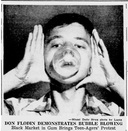
Deprived of bubblegum during World War II, America's youth went crazy for the stuff when production resumed in 1946. Yep, this actually happened. Production of more than 20 bubblegum brands stopped during the war because of latex and sugar shortages. When companies started making it again, the kids went nuts and would swarm candy stores whenever fresh supplies were delivered.
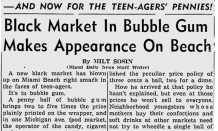
Enterprising young capitalists would buy out stores' entire stock of what then sold for a penny, then gouge their little friends by reselling for up to a dollar apiece, according to a 1983 story in the Pittsburgh Press. When retailers in Philadelphia tried to cash in by doubling their price to two-cents apiece, a group of youngsters sent a formal grievance to the federal government. In Miami, a Michigan Avenue store raised its price to three cents apiece and an Espanola Way store was peddling the precious gum for a dime, the Miami News reported. "The boys and girls are indignant about bubble gum prices," the story said. "In fact, it's one bubble they'd like to see burst." Read the story in the Miami News: Black Market In Bubble Gum Makes Appearance on Beach • Read the story in the Pittsburgh Press: The Great Inflation - Bubble Gum
March 19, 1960: 2,000 evacuated after four days of Tampa flooding
|
|
As flooding moved into a third section of Tampa, National Guardsmen prepared to evacuate more families in addition to 2,000 residents displaced from 500 homes over four days, according to a story in the St. Petersburg Times. Guardsmen and volunteers told 75 families along the swollen Hillsborough River to prepare for evacuation after waters reached 4.5 feet in their area. By March 22, the number of evacuees rose to 8,000, the paper reported.
|
Flashboards on a city waterworks dam five miles from the heart of Tampa broke on March 18, sending millions of gallons rushing downstream. The flooding was caused by several days of torrential rains earlier in the week. Statewide, about 1,000 homes were inundated with up to 15 feet of water, the Red Cross said. Read the story in the St. Petersburg Times: Flood Spreads to Other Areas of Soggy Tampa
March 18, 1989: The day Spring Break devoured Daytona Beach
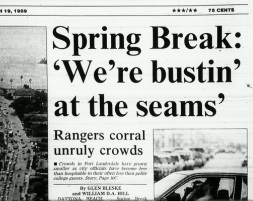
Fort Lauderdale points to a single year - 1985 - for its decision to stop promoting Spring Break. Officials in Daytona Beach point to a single day: March 18, 1989. That was the Saturday that so many young people arrived, "roads turned into parking lots," according to a story in the Daytona Beach News-Journal. Most of the problems weren't caused by visiting college students but by Central Florida residents drawn by the endless promotion on radio, newspapers, and by live coverage by a cable network that once played music videos called MTV. By 10 a.m., all beach parking spots were filled between Ormond Beach and Port Orange. Major roads between I-95 and the beach were jammed throughout the day. There was much beer drinking. Beach rangers dispersed more than 200 people from the scene of a fight at the U.S. 92 beach ramp before 2 p.m. Another disturbance near the Ocean Deck bar involved 90 people. At around 2 p.m., fights on the beach drew crowds of 200 and 400 people. Then other fights started. It "looked like a riot," said Chief Beach Ranger John Kirvan. Paramedics received hundreds of calls throughout the day, but gridlocked roads made it difficult for them to respond.
|
|
"We've got Central Florida here. We're bustin' at the seams," Kirvan said. While Spring Break and the local resort industry's promotion of the event didn't end after 1989, the gridlock and problems resulting from March 18 forever changed the community's attitude toward it. From then on, Spring Break was no longer an event to be promoted. It became a problem to be solved.
|
March 17, 1946: Robinson breaks color barrier in Daytona Beach
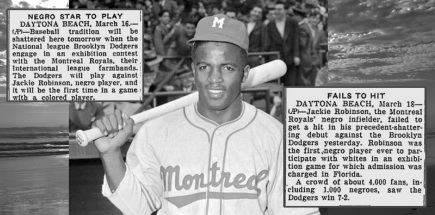
Close to 4,000 fans, including 1,000 African Americans, were in the grandstands of Daytona Beach's City Island Ballpark to watch Jackie Robinson become the first black player to play in a major league baseball game. Robinson was playing for the Montreal Royals, a farm team of the Brooklyn Dodgers, which signed him the previous year. The two teams were unable to play a scheduled exhibition game in Jacksonville after the mayor ordered the city's ballpark padlocked. Robinson found a more acceptable environment in Daytona Beach, home of black education pioneer Mary McLeod Bethune and the college she founded, Bethune-Cookman College. At the game, only a smattering of boos were heard when Robinson was announced while spectators in a segregated section of the grandstands cheered mightily. Robinson failed to get a hit in his debut, and most Florida newspapers downplayed the milestone, either because they didn't want to offend Southern sensibilities or because they wanted to avoid the possibility of a racial confrontation. In 1988, the city of Daytona Beach honored the park's place in American history by renaming City Island Ballpark as Jackie Robinson Ballpark. In another proud milestone this year, Daytona Beach renamed the ballpark again, to Radiology Associates Field at Jackie Robinson Ballpark. Read the story in the Daytona Beach News-Journal: Jackie Robinson more than a memory
Update: 3/17/2014, 8:30 p.m. Linda Waterman in I Grew Up In Daytona Beach #2 pointed out we were mistaken. Only the ballpark's field has been renamed to Radiology Associates Field at Jackie Robinson Ballpark. The ballpark itself remains Jackie Robinson Ballpark.
Update: 3/17/2014, 8:30 p.m. Linda Waterman in I Grew Up In Daytona Beach #2 pointed out we were mistaken. Only the ballpark's field has been renamed to Radiology Associates Field at Jackie Robinson Ballpark. The ballpark itself remains Jackie Robinson Ballpark.
March 16, 1966: Gemini 8 aborted after first in-space emergency
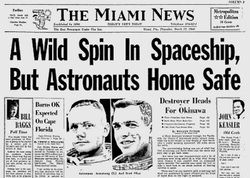
After blasting off safely from Cape Kennedy and conducting the first docking of two spacecraft in orbit, the Gemini VIII spacecraft suffered the first critical in-space system failure, putting the lives of astronauts Neil Armstrong and David Scott in danger and forcing the mission to be aborted. It was the sixth manned mission of the American space program. The emergency occurred after the Gemini spacecraft was docked with the Agena Target Vehicle, and the combined craft began spinning in space. The astronauts undocked from the Agena, but Gemini continued spinning at a rate that reached one revolution per second, giving the astronauts blurred vision and putting them in danger of losing consciousness.
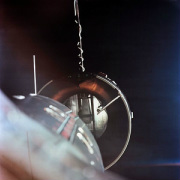 Gemini VIII docks with Agena
Gemini VIII docks with Agena
Armstrong stopped the spin by firing Gemini's re-entry thrusters, but in doing so, used about 75 percent of the craft's re-entry fuel. Mission rules dictated that the flight must be aborted if re-entry thrusters were fired for any reason, and the crew immediately started planning an emergency landing. Original plans called for the craft to land in the Atlantic Ocean, but they instead re-entered Earth's orbit above the Pacific, splashing down about 500 miles east of Okinawa, Japan, where they were picked up by a Navy destroyer, USS Leonard F. Mason. NASA initially refused to release tape of the communications between the astronauts and controllers on the ground, saying the astronauts' remarks might be misinterpreted. But news accounts revealed their heart rates had doubled during the emergency, indicating the severity of the crisis. Later tests indicated an electrical short as the most likely cause of the malfunction. Read the story in the Miami News: A Wild Spin In Spaceship, But Astronauts Home Safe
March 15, 1953: Cyclist, fan die in Daytona 200 beach course crash
|
Veteran motorcycle racer Cliff Farwell and a fan died in a ghastly collision during the Daytona 200 race. The crash happened in the 11th lap when spectator Charlie Gerrard walked onto the course as Falwell, 39, sped up the backstretch at more than 110 mph, the Daytona Beach Morning Journal reported.
|

Farwell's motorcycle hit Gerrard, then went straight up in the air and hurtled off the course before hitting another spectator, Joesph Stahle. Farwell, runner up in the 1952 race, and Gerrard were killed instantly while Stahle was sent to the hospital in critical condition.
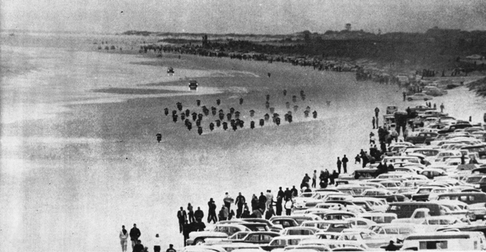 Photo of Daytona 200 start, year unknown, illustrates hazards to spectators in the 1950s
Photo of Daytona 200 start, year unknown, illustrates hazards to spectators in the 1950s
Another crash in the same race critically injured two riders -- Jimmy Chann and Don Nichols -- and injured a Daytona Beach boy who was watching the race. Nichols died a week later at Halifax Hospital. The crash prompted concerns about safety to spectators along unsecured stretches of the two-mile beach course. In 1961, the race moved to the new Daytona International Speedway.
Read the story in the Daytona Beach Morning Journal: 2 Die In Race; Goldsmith Wins
Read an account in the blog, Rider Files: From the Beach to the Speedway
Read a commentary from Cycle Magazine posted in the blog, GeekBobber
Read an account in the blog, Rider Files: From the Beach to the Speedway
Read a commentary from Cycle Magazine posted in the blog, GeekBobber
March 14, 1903: Nation's 1st wildlife refuge created at Pelican Island

A German immigrant's crusade to save water birds from slaughter led the federal government to create the nation's first wildlife refuge at Pelican Island, in the Indian River Lagoon near Sebastian. Paul Kroegel lived with his father on the west bank of the Indian River in the late 19th century. From his home, he could see a five-acre mangrove island where thousands of herons, spoonbills, egrets and pelicans would roost and nest. But the birds were under constant attack from hunters seeking to harvest their feathers for sale as fashion accessories. No state or federal law protected the birds, and Kroegel started boating out to the island and standing guard with his gun.
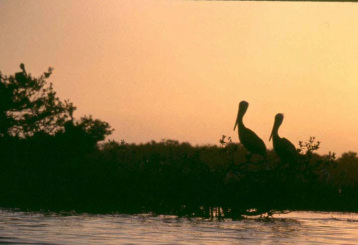
Over time, Kroegel became acquainted with naturalists and conservationists, including Frank Chapman, curator at the American Museum of Natural History and a member of the American Ornithologist's Union. In 1901, the ornithologists teamed with the Florida Audubon Society to convince Florida legislators to pass laws protecting non-game birds. Kroegel was one of four wardens hired by the Florida Audubon Society to protect the water birds from hunters. Two of the wardens were murdered in the line of duty. Chapman had access to President Teddy Roosevelt and visited the president to persuade him to create additional protections. Roosevelt signed an executive order on March 14, 1903 establishing Pelican Island as the first federal bird reservation. Kroegel was hired as the first national wildlife refuge manager at a salary of $1 a month. During his presidency, Roosevelt established a network of 51 federal bird reservations, four national game preserves, 150 national forests and five national parks.
Click here to visit the U.S. Fish and Wildlife Service's Pelican Island web page.
Click here to visit the U.S. Fish and Wildlife Service's Pelican Island web page.
March 13, 1938: Tolstoy grandson heads team seeking 'sea monsters'
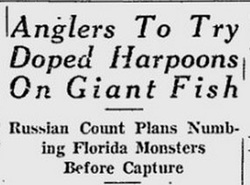
Fishermen armed with hypodermic harpoons will search the Atlantic Ocean off Florida's coast for "giant sea monsters" to display in the world's largest aquarium being built 20 miles south of St. Augustine, the Miami News reported. Count Illia Tolstoy, naturalist and grandson of the writer Leo Tolstoy, invented the large-scale harpoons "to lull the monsters of the deep into a state of unconsciousness and assure their capture," the story said. The brief story seemed to overhype plans for what just a few months later, on June 23, opened as Marineland Studios. Creatures on hand for the opening were a manta ray, a 14-foot sawfish, penguins and two bottlenose dolphins. Twenty thousand attended the opening day ceremonies.
|
|
Tolstoy was one of four founders -- the others were W. Douglas Burden, Cornelius Vanderbilt Whitney and Sherman Pratt -- of the attraction, first conceived as an oceanarium that could be used to film sea life. Movies filmed there included Creature of the Black Lagoon (1954), released 50 years ago.
|
Read the story in The Miami News: Anglers To Try Doped Harpoons On Giant Fish • Read the story in the Daytona Beach Morning Journal: Thousands Attend Formal Opening of Aquarium • Go to Marineland's website: marineland.net
March 12, 1953: Columnist, novelist Carl Hiaasen born in Plantation
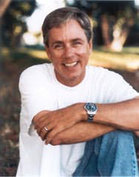 Carl Hiaasen
Carl Hiaasen
Considered by many as the sharpest commentator on the modern Florida experience, writer Carl Hiaasen was born in Plantation on this date in 1953. He is best known as a satirical columnist for the Miami Herald, and he continues to write for the paper today. He was hired by the Herald in 1976. His fiction books include Tourist Season (1986), Double Whammy (1987), Sick Puppy (2000) and Basket Case (2002). His 1993 novel Strip Tease was released in 1986 as a film, Striptease, starring Demi Moore and Burt Reynolds. His latest book, Bad Monkey, is a murder mystery set in Key West. He has also written four novels for young adults. Hoot, published in 2002, was released as a film in 2006 by director Wil Shriner.
Quotes about Florida by Hiaasen from the website Brainyquote.com:
• "The Florida in my novels is not as seedy as the real Florida. It's hard to stay ahead of the curve. Every time I write a scene that I think is the sickest thing I have ever dreamed up, it is surpassed by something that happens in real life."
• "The first rule of hurricane coverage is that every broadcast must begin with palm trees bending in the wind."
• "Disney's something to be a little alarmed about. It's not just a little theme park anymore. It's now an ethic and outlook and strategy that goes way beyond central Florida."
• "I think in the old days, the nexus of weirdness ran through Southern California, and to a degree New York City. I think it's changed so that every bizarre story in the country now has a Florida connection. I don't know why, except it must be some inversion of magnetic poles or something."
Check out Carl Hiaasen's website: carlhiaasen.com • Carl Hiaasen's latest columns in the Miami Herald
Quotes about Florida by Hiaasen from the website Brainyquote.com:
• "The Florida in my novels is not as seedy as the real Florida. It's hard to stay ahead of the curve. Every time I write a scene that I think is the sickest thing I have ever dreamed up, it is surpassed by something that happens in real life."
• "The first rule of hurricane coverage is that every broadcast must begin with palm trees bending in the wind."
• "Disney's something to be a little alarmed about. It's not just a little theme park anymore. It's now an ethic and outlook and strategy that goes way beyond central Florida."
• "I think in the old days, the nexus of weirdness ran through Southern California, and to a degree New York City. I think it's changed so that every bizarre story in the country now has a Florida connection. I don't know why, except it must be some inversion of magnetic poles or something."
Check out Carl Hiaasen's website: carlhiaasen.com • Carl Hiaasen's latest columns in the Miami Herald
March 11, 1921: 6th Annual Seminole Sun Dance wrapping in WPB
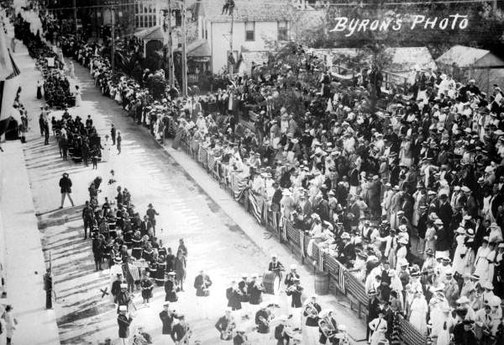 Seminole Indians perform at Seminole Sun Dance. Year unknown. Photo: Florida Memory
Seminole Indians perform at Seminole Sun Dance. Year unknown. Photo: Florida Memory
When West Palm Beach business leaders decided to organize a Mardi Gras-style festival early in the 20th century, they needed a theme. Apparently, the obvious themes -- mansions, rich people, boating, rich peoples' boats, big hotels, servitude, and pineapple farming -- weren't considered appealing. So they decided on Seminole Indians and called the festival "Seminole Sun Dance." It didn't matter that Florida's Seminole Indians, just a few decades after warring with the U.S. government, weren't native to Florida and didn't even have a Sun Dance. Seminole Indian tribes were coaxed from the Big Cypress Swamp to come march in the big parade, compete in canoe races and dance.
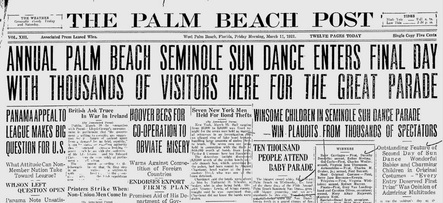
The festival, targeted to tourists at the end of the winter season, had something for everyone: a carnival midway, agricultural displays, airplane exhibitions, a "Miss Popular Lady" contest, a children's parade and a baby pageant. Organizers appealed to residents to participate, according to a story in the Palm Beach Post: "Director General W.A. Dutch made an appeal yesterday for everybody in West Palm Beach to turn out in their Palm Beach suits and join the escort that will march with the Indians from the city docks to the grand stand where the Pipe of Peace will be smoked and Mayor D.F. Dunkle will give a 'heap big talk'; after which the tribal medicine will be read by Senator T.J. Campbell."
While local children were outfitted in Indian costumes, other residents were encouraged to show up in their "Palm Beach suits" apparently to contrast with the traditional garb of the Indians and emphasize the joining of the cultures. The big parade, on the last day of the festival, was called "The Grand Phantasmagoria." The festival ran for eight straight years in March between 1916 and 1923, and sporadically after that until it was last staged in 1960. The festival eventually morphed into today's SunFest, a five-day music festival with multiple bands, floating barges, fireworks, Captain Morgan's Rum but no dancing Seminoles. Read this historical account from the Palm Beach Post: Sun Dance aimed to rival Mardi Gras • Read a story in The Tropical Sun detailing a planning banquet for the 1919 Sun Dance • Check out Sun Dance photos available for purchase from the Historical Society of Palm Beach County
While local children were outfitted in Indian costumes, other residents were encouraged to show up in their "Palm Beach suits" apparently to contrast with the traditional garb of the Indians and emphasize the joining of the cultures. The big parade, on the last day of the festival, was called "The Grand Phantasmagoria." The festival ran for eight straight years in March between 1916 and 1923, and sporadically after that until it was last staged in 1960. The festival eventually morphed into today's SunFest, a five-day music festival with multiple bands, floating barges, fireworks, Captain Morgan's Rum but no dancing Seminoles. Read this historical account from the Palm Beach Post: Sun Dance aimed to rival Mardi Gras • Read a story in The Tropical Sun detailing a planning banquet for the 1919 Sun Dance • Check out Sun Dance photos available for purchase from the Historical Society of Palm Beach County
March 10, 1962: Yanks play first spring training game in Lauderdale
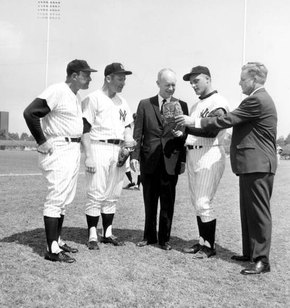 Gov. Bryant with Yankees in 1962. Florida Memory
Gov. Bryant with Yankees in 1962. Florida Memory
The New York Yankees played their first game at the new Fort Lauderdale Stadium in 1962 after moving their spring training headquarters from St. Petersburg. The team stayed in the city until 1995 before moving to Tampa. The Baltimore Orioles took over the stadium afterward and played until 2009 before moving to Sarasota. Fort Lauderdale Stadium has not hosted a major league baseball game since then. In fact, after more than a century of spring training baseball in Dade and Broward counties, the annual ritual has ceased to exist south of Jupiter, the shared headquarters of the Miami Marlins and St. Louis Cardinals, located 61 miles north of Fort Lauderdale and 88 miles north of Miami in northern Palm Beach County.
Wall Street Journal reporter Jeff Pearlman lamented the absence of baseball from Fort Lauderdale in a March 2011 essay headlined, Baseball Left, Never Looked Back. Pearlman wrote that the Yankees moved originally moved to Fort Lauderdale because the team's St. Petersburg hotel refused to allow black players to stay there.
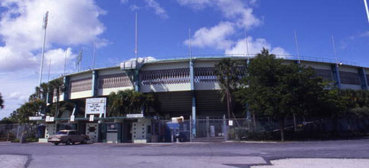 Fort Lauderdale Stadium. Photo: Florida Memory
Fort Lauderdale Stadium. Photo: Florida Memory
"Fort Lauderdale was this up-and-coming hot place to be," the team's former media relations director told Pearlman. The movie, "Where the Boys Are," had just put the city on the national map. "The Yankees arrived in the spring of 1962, the greatest franchise in baseball coming off, arguably, the greatest season in baseball," the story said. Checking into the new team hotel, the Yankee Clipper, was baseball royalty: Micky Mantle, Roger Maris, Yogi Berra and Whitey Ford. Legend Joe DiMaggio arrived at the hotel as a spring instructor with Marilyn Monroe on his arm.
Fort Lauderdale Stadium, built to resemble Yankee Stadium, "was a jewel among sludge," Pearlman wrote. Local dealer Slaton Chevrolet gave each player a free car to drive. Pubs and nightclubs let them drink for free. Bikini-clad groupies combed the city, hoping to meet players.
Later, of course, came George Steinbrenner, Thurman Munson, Lou Piniella, Reggie Jackson. "You know what was great about Fort Lauderdale stadium?" asked early-80s catcher Rick Cerone. "It was that we were genuinely beloved."
Read the story in the Wall Street Journal: Baseball Left, Never Looked Back • Read a summary of the Yankees' first game in Fort Lauderdale in the Miami News
Fort Lauderdale Stadium, built to resemble Yankee Stadium, "was a jewel among sludge," Pearlman wrote. Local dealer Slaton Chevrolet gave each player a free car to drive. Pubs and nightclubs let them drink for free. Bikini-clad groupies combed the city, hoping to meet players.
Later, of course, came George Steinbrenner, Thurman Munson, Lou Piniella, Reggie Jackson. "You know what was great about Fort Lauderdale stadium?" asked early-80s catcher Rick Cerone. "It was that we were genuinely beloved."
Read the story in the Wall Street Journal: Baseball Left, Never Looked Back • Read a summary of the Yankees' first game in Fort Lauderdale in the Miami News
March 9, 1976: Carter upsets Wallace to win Florida primary
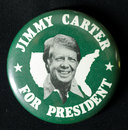
Former Georgia Gov. Jimmy Carter pulled off a major upset by defeating Alabama Gov. George Wallace in the state's Democratic presidential primary. To this day, political observers consider this the last meaningful Florida primary. Carter called the win "hard to believe" because the conservative Wallace had decisively won the state's primary in 1972 with 41.6 percent of the vote. Carter didn't get that much in 1976 -- 35 percent to Wallace's 31 percent -- but the upset victory made Carter the national front runner and was the last major hurdle in his quest for the nomination. Carter campaigned hard leading up to the Florida primary because many expected Wallace to easily win again in the state. But attitudes were changing. The Democratic Party had moved left nationally in the Vietnam era. Wallace still carried baggage from his opposition to racial desegregation in the 1960s while Carter campaigned as a leader of the post-racist "New South." Carter was elected president that November but served only one-term, largely because of his ineffective response to the Iranian hostage crisis of 1979-1980. He lost his 1980 bid for re-election to former California Gov. Ronald Reagan. Read the story in the St. Petersburg Times.
March 8, 1943: Sarasota 'trailerite' is thrifty, resourceful, adventurous
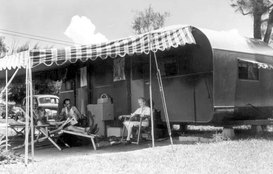 Sarasota trailer tourists, 1946. Florida Memory
Sarasota trailer tourists, 1946. Florida Memory
Trailer park tourism was in high gear in Sarasota in March 1943, and the Sarasota Herald-Tribune ran a regular feature, "City Tourist and Trailer Park News." Columnist Irma Tuhey, responding to "numerous requests," revisited her previous year's interview with Rev. John Humphrey originally headlined, "A Clergyman's Impression of the Trailerites." Rev. Humphrey offered respect and praise for the seasonal visitor.
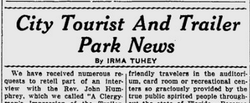
"The trailerite is usually a thrifty man. As a farmer, merchant or professional man, he has shown sufficient diligence and foresightedness to lay aside something for the future and when overtaken by age, sickness or misfortune he can benefit himself by travel and change assured him by his own savings," Humphrey said. He is often exacting in the way he maintains his equipment, unique in his educational proficiency, and generous when asked to purchase war bonds or give to the Red Cross. The trailerite is "far removed from the irresponsible, ne'er-do-well vagrant found in every countryside." He doesn't like shackles. "The blood of the true explorer, colonizer and missionary is in his veins and the sturdy old pioneer comes to life in him." Though sometimes drawn to solitary pursuits, "for the most part, the camp is his delight," Humphreys said. "His social instincts and neighborly aptitudes lead him to our parks where the periodical greeting is as warm and sincere as the family reunion." To read the story in the Sarasota Herald-Tribune, click this link and scroll to the bottom middle of the page.
March 7, 1935: Sir Malcolm Campbell sets new land speed record
|
Rocketing down the hard-packed sands of Daytona Beach, former Royal Flying Corps pilot Sir Malcolm Campbell set a new land speed record of 276.816 mph in his car Bluebird II. It was the fourth record set by Campbell on the beach, following speeds of 246.088 in 1931, 253.968 in 1932 and 272.468 in 1933. The latest mark was somewhat of a disappointment as he had hoped to break the 300 mph barrier.
|
|
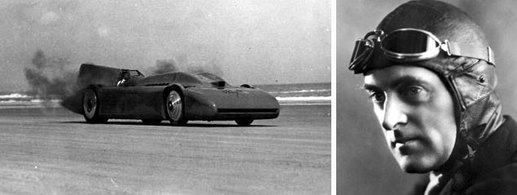 The Bluebird II and Sir Malcolm Campbell. Photo: State Archives of Florida, Florida Memory
The Bluebird II and Sir Malcolm Campbell. Photo: State Archives of Florida, Florida Memory
With this run, he realized the limitations of the beach course and in September of that year took the Bluebird II to the hard-as-concrete Bonneville Salt Flats of Utah, where he finally exceeded 300 mph. Campbell next turned to water-speed racing and set three records before dying of a stroke in 1948 at age 63. Read the story in The Miami News: New Record of 276.816 Chalked Up • Read the story at History.com: Campbell exceeds 300 mph
March 6, 1945 - Look mag to Miami Beach: This ain't no party!
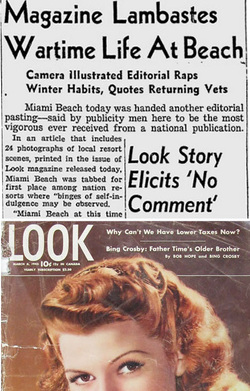
When should a resort not act like a resort? When the nation is at war, according to Look Magazine. The now-defunct twice-monthly national magazine, known more for celebrity pictorials than biting political criticism, ruffled feathers with a feature accusing Miami Beach of ignoring the war effort while luxuriating on beaches and around swimming pools, The Miami News reported. Headlined "Do We Know There's a War On?," the story quoted a serviceman as wanting to see "this place bombed to hell!" Accompanying a large photo of a packed swimming pool deck, the magazine wrote, "These citizens have nothing to do but bask in the sun, lunch leisurely or play cards beside the swimming pool." The article further states, "Miami Beach at this time of year offers probably the greatest concentration of war-money-to-burn citizenry from every state in the union." Other photos showed a platter of steaks, gamblers at Miami's jai alai fronton, and scantily clad nightclub dancers. The magazine acknowledged "some good works toward servicemen" but added that the Community Chest of Dade County collected less than two-thirds of its $695,000 quota during the recent three-week drive. Read the story in the Miami News: Magazine Lambastes Wartime Life At Beach
March 5, 1958: Gov. Collins voices disbelief over reports of beatings at Marianna reform school where 55 bodies were exhumed in 2014
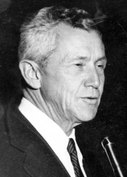 Gov. Leroy Collins
Gov. Leroy Collins
Reacting to detailed reports that boys sent to a Marianna reform school were regularly beaten with a leather strap, Gov. Leroy Collins voiced disbelief that the school's superintendent, Art Dozier, would ever permit such a thing. "I can't believe that there is any brutality going on there or that Mr. Dozier would be permitting anything wrong," Collins told the Miami News. Collins was responding to testimony by Dr. Eugene Byrd, Miami psychologist and a former staff member at the Marianna Industrial Training School for Boys before a U.S. Senate subcommittee on juvenile delinquency in Washington.
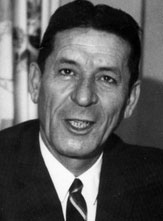 Arthur G. Dozier
Arthur G. Dozier
Dozier has admitted that boys are regularly paddled with a leather strap at the school, but said it was preferable to the alternative of solitary confinement. Collins said he was "shocked" that anyone would find fault with Dozier's operation, "which I have heard described many times both in and outside the state as an almost model institution of its type." Reports of the beatings prompted numerous calls to the paper from former inmates who reported being beaten until blood seeped through their pants. Regular whippings took place on Saturday mornings in a building called "The White House." Mothers told the paper their sons had to be sent to the hospital to be bandaged after the beatings, and some were left unable to walk.
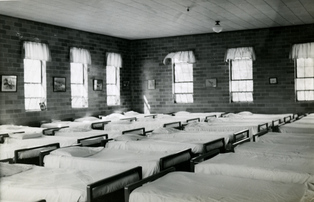 Dormitory at Marianna school. Photo: Florida Memory
Dormitory at Marianna school. Photo: Florida Memory
Despite the reports, corporal punishment was not prohibited at the school until 1968. The school was finally closed in 2011 after decades of investigations into horrific allegations of abuse, torture, rapes, beatings and murder. The state allowed it to remain in operation for 111 years, and in 1967 changed its name to the Arthur G. Dozier School for Boys, in honor of the former superintendent.
In January of this year, researchers from the University of South Florida announced they had exhumed the remains of 55 children at the school site -- 24 more than had been recorded in the school's records. Some were found in unmarked, shallow graves. Researchers are continuing to look for bodies at the site, and reports of unbelievable abuse continue to mount.
Read the story in the Miami News: Beatings Shock Collins • Read the story in Mother Jones: "It Was Kind Of Like Slavery" • Read the story in The Tampa Tribune: Bob Martinez takes up fight to get reparations for Dozier victims
In January of this year, researchers from the University of South Florida announced they had exhumed the remains of 55 children at the school site -- 24 more than had been recorded in the school's records. Some were found in unmarked, shallow graves. Researchers are continuing to look for bodies at the site, and reports of unbelievable abuse continue to mount.
Read the story in the Miami News: Beatings Shock Collins • Read the story in Mother Jones: "It Was Kind Of Like Slavery" • Read the story in The Tampa Tribune: Bob Martinez takes up fight to get reparations for Dozier victims
March 4, 1948: Motorcyclists will behave, Daytona police declare
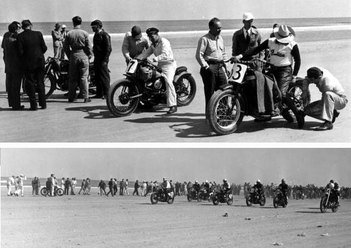 Motorcycles race on beach, 1947. Photo: Florida Memory
Motorcycles race on beach, 1947. Photo: Florida Memory
Stepped-up enforcement against noisy and speeding motorcyclists will ensure less horseplay during Daytona Beach's annual motorcycle races compared to previous years, police officials vowed. Law enforcement officials met with the Chamber of Commerce's Safety Committee to plan for the following week's motorcycle races, the Daytona Beach Morning Journal reported. New measures would include impounding lawbreakers' motorcycles until after the races, stationing Florida Highway Patrolmen on roads leading into the city to halt motorcycle convoys without mufflers, and barricading Main Street "so that cyclists will not be able to indulge in antics there as they did last year," the story said. In addition, motorcyclists will be kept busy with a 95-mile endurance race, dances and a fish fry. Chamber chairman Wilmans Baggett said motorcyclists have generated $4 million for the area since the races were started in 1937. The only trouble is "rowdyism," he said. E.C. Smith, national secretary for the American Motorcycle Association, said members have been notified that if they fail to behave, there will be no more races. In 1947, The Daytona Beach Hotel Association asked city officials to schedule future races during April or May after the Winter season because the noise disturbs "regular visitors." Today, the races -- and what is now called Bike Week -- are held in March. Read the story in the Daytona Beach News-Journal: Motorcyclists, Cycles To Be Muffled
March 4, 1824: Tallahassee becomes official capital of Florida territory
(From Florida Historical Society) Tallahassee officially became the capital of the territory of Florida on this date. Prior to this date, Florida was broken up into two colonies by the British in 1763, East and West Florida. Each colony had its own capital, Pensacola in West Florida and St. Augustine in East Florida. The Spanish continued this administrative separation during the Second Spanish Period (1783-1821). After the United States acquired Florida as part of the Adams-Ońis Treaty of 1819, the territorial government chose a site that was halfway between the two previous colonial cities. Tallahassee had previously been occupied by pre-Colombian societies, and also by Creek and Seminole Indians. The Spanish also built a large mission in Tallahassee known as Mission San Luis de Apalachee, which has been partially reconstructed on its original site. Tallahassee remains the capital of the state of Florida and is the county seat and largest city in Leon County.
March 3, 1845: Happy Birthday, State of Florida
|
Florida was admitted as the 27th state of the union on this date in 1845. On its 100th birthday in 1945, the Library of Congress in Washington D.C. exhibited maps, manuscripts, books and prints marking the occasion, the Miami News reported.
|
If Florida's history as a slave state was emphasized in the exhibit, the newspaper did not mention it. Still, "it was "the most complete showing of rare documentary material on the state ever assembled in this country," the acting librarian said. Sen. Claude Pepper told the story of the state's development from a scrubland to a modern tourism center, renowned for fishing, fruit and vacations. Florida congressmen spoke about the state for 45 minutes and invited colleagues to see the exhibit. A special message from Marjorie Kinnan Rawlings, author of "The Yearling," was entered into the Congressional Record. She wrote that Florida has "such an array of garden flowers and green vegetables as to make one wonder why the capitol of the United States was not placed in the Florida Eden instead of Washington. ... And the climate! Take the lies of California, and in Florida, they are true." Read the story in the Miami News: Library of Congress Observes 100th Anniversary of Florida
March 2, 1972: House OKs creation of environmental 'superagency'
The state House approved creation of a new environmental protection agency that combined several smaller agencies and gave the governor authority to appoint its secretary. An 82-26 vote to create what would become the Department of Environmental Regulation settled a political battle between House leaders and members of the state Cabinet who would lose authority over departments that would be absorbed into the new "superagency." The merger combined the Pollution Control Department and portions of the Department of Natural Resources and Internal Improvement Trust Fund. The new agency would regulate the state's air and water quality and make land management decisions, primarily related to shorelines and wetlands. It would also supervise the five water management districts established in 1972. By the early 1990s, the department was the nation's third-largest environmental regulation agency, with 1,500 employees and a $650 million budget. In the mid-1990s, it was merged with the Department of Natural Resources to create the Department of Environmental Protection. Read the story in the St. Petersburg Times: House Votes to Create Environment Superagency
March 1, 1983: Spring Break begins in Fort Lauderdale
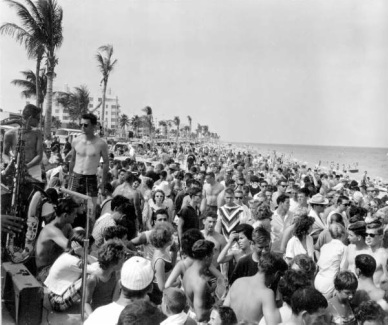 Spring Break in Fort Lauderdale, 1962. Photo: Florida Memory
Spring Break in Fort Lauderdale, 1962. Photo: Florida Memory
College students celebrated the official start of Spring Break in Fort Lauderdale, and the local and national media played its role by covering the drunken activities with its usual mix of titillation, scorn and bemusement. Let's take a trip down the strip. First stop: The iconic Elbo Room, famous from the 1961 movie "Where The Boys Are." By 3 p.m., "the sounds of old rock 'n roll records made conversation difficult to hear," the Miami News reported. There, we meet a young man suddenly too broke to pay for a beer. Darting out to A1A, we find ice cream shops, hamburger joints and shops that sell bikinis so skimpy the mannequins could get arrested in most towns. Guys oogle girls. Girls oogle back. Men are so drunk they stumble over each other as they gawk at scantily clad women. Then we get to The Button, favorite bar of students from Penn State, Ball State, and even Northwood Institute Junior College. "It's great," says Jan Cullis, 22, senior from Penn State. "It's like you are in a whole other world. Nothing you do here counts. You can do anything you please and it doesn't matter." A D.J. is conducting the "Banana Eating Contest," "The Wet Willie Extravaganza," and "The Wet T-Shirt Extravaganza." There was much gyrating on stage. This year's Spring Break is expected to draw 250,000 to Fort Lauderdale, the story said. By 1985, the publicity and several Spring Break-themed movies set in South Florida will lure even more students to the town, triggering the backlash that today makes this a source of nostalgia. Read the story in the Miami News: Fort Lauderdale pops the top on world's biggest beer bust • Check out a gallery of classic Spring Break images from the South Florida Sun-Sentinel • Watch TV news report on record-setting business in Fort Lauderdale in 1985


